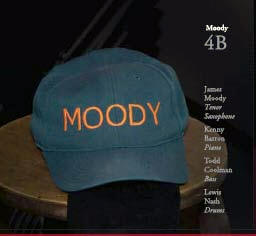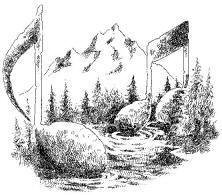|
You are reading the older HTML site
Positive Feedback
ISSUE
50
Moody 4B
James Moody, tenor sax; Kenny Barron, piano; Todd CoolMan, bass; Lewis Nash, drums. Avatar Studios, July, 2008. Wm. Sorin, producer. (IPOC 1017) In the beginning was James Moody… or so it sometimes seems. Of all the great players in jazz at present (and for a long while), few rival Moody in youthful cheerfulness and just plain musical and melodic exuberance. "Moody's Mood For Love" has doubtless paid for several hundred steak dinners in Moody's eventful life, but it is no exaggeration to say that James Moody is one of the most loved, adored and welcomed jazz musicians on the scene today—and over the last forty-plus years. Increasingly Moody's stature threatens to obliterate the authoritative hipness of his playing. You can admire and respect a musician for his knowledge and execution (his "chops") and you can love a musicians because he is warm and friendly, like an old pal you never see enough. The beautiful, strange truth of Moody's existence is that both forms of respect and admiration flow to him on a daily basis. One might wonder, in all philosophical sobriety, what it could possibly feel like to have an adoring wife (Linda) and a legion of close professional friends along with a serious base of well-wishers who are not a part of your inner circle: all of whom greet you as a continuously Returning Son who might solve global gloom. Good vibes follow Moody everywhere he goes. In fact, they land at his many destinations in advance of his arrival, awaiting sweet moments of friendship with an artist about whom it's not over-ripe to report that "his like will not be seen again." It comes to this. James Moody is one of a kind. Bill Sorin's label, IPO, here features a new quartet album, B4, under Moody's command. It may be IPO's greatest album to date. On one hand, it is a strong studio gig but, on the other hand, it is uniquely iconoclastic (that ultimate level of envious surprise) because no one sounds like James Moody and no one plays like James Moody... since no one else can BE James Moody now or ever more.
Benny
Golson says that one Moody is exactly right. Within that glow, listen to Golson's endearing standard here,
"Along Came Betty," I recently recorded
Maestro Golson in Vienna. His treatment of his own timeless song is unmatched.
And yet, when James Moody leans into a song, something unsuspected always
occurs. What that particular surprise may be is virtually impossible to
predict. The simple reason for one's uncertainty and good luck has everything
to do with the inherent complexity of this ageless musician's ferocious
imagination. That ne plus
ultra is in force, with dignity and elegant savoir faire on this
version of "Betty"... and Moody grasps the bittersweet melodic line as if he had
written it (or wanted to). The secret index of Moody's iconoclasm and surprise
has everything to do with his authority as an original "saxophone phenom."
To
younger generations of jazz listeners, James Moody's majestic entry into
full-fledged jazz stardom in the '40s, when he joined Dizzy Gillespie's big
band, is lost in the bowels of an hilarious era of jazz history. Moody became
the object of endless buzz among fellow jazz musicians because, quite literally,
he possessed those gifts called "perfect pitch" and "infinite auditory recall." Moody heard a song and it was his, no sheet music needed. He heard any song's
changes and owned them, no rehearsal or matchbook cover cribs. Moody was a
tyro and everyone loved his insouciance and brio.
Along
came composer-trombonist Tom McIntosh who lent his considerable intellectual and
artistic skills to hip this god sent force of saxophonic nature to formal
intervallic variations, traditional chord displacement, and all things that
demand sight reading of charts. That gesture of genuine love and fellowship put
McIntosh into the doghouse with many who loved Moody exactly as he was,
unblemished. No good deed goes unpunished. Let the record show that James
Moody has always prevailed, no matter what. And let it show, too, that Tom
McIntosh—who turned down a gig, offered by Duke Ellington, to replace the
immortal Billy Strayhorn after "Sweet Pea" passed away, leaving Duke
disconsolate and in need of a brilliant arranging-compositional
sidekick—triumphed on self-made terms, no less than Moody did, writing
television and film sound scores in Hollywood and elsewhere.
James
Moody's unmatched authority on his main instrument, the tenor sax, derives from
vast, calm self-confidence. Let me amplify. Moody's been there, done that,
with everyone who is and was "someone" in the long jazz pantheon. He has
overcome rookie mistakes, adolescent excesses, and learning curves that
increasing maturity demands. Moody has, simply, ingested it all, tucked it into
his ample consciousness… and moved on down the road with that beautiful relaxed
gait that suggests "no fear, no prisoners taken."
James
Moody's authority as a musician (this is true of his flute playing no less than
his sax work) rests with his awareness that he has no need to reach or strain
for effects. It stands within his profound "grounding," and artistic solidity,
as an deeply emotional and elegantly imaginative person. Moody plays, as James
Joyce noted ninety years ago, the way "God pares his nails."
That,
students, is authority. You hear it with every note he plays on this album—which surely must make its producer, Bill Sorin, proud. Every young saxophonist
on earth can take an indelible lesson from Moody all across this low-keyed,
brilliant recording. Listen to how deep inside himself Moody's thought and
feeling are. I do not mean to exaggerate an inch when I suggest that the calm
lucidity of Moody's playing here "sounds like" a man, in the early 21st
century meditating on things born of love, life and pain—much as William
Shakespeare did in his sonnets.
My
initial encounter with James Moody's playing was in the late-'50s when his then
crucial album, "The Last Train From Overbrook," emerged. The jazz station for
St. Louis, where I lived on the west side, was located in East St. Louis. When
I heard Moody's plaintive musical acumen, his sound literally floated across the
Mississippi to my house at the edge of Forest Park, the closest house in the
city to the St. Louis Zoo. You might imagine that, thirty years later, meeting
James Moody and working with him on occasion at Elario's Jazz Club in La
Jolla was a marvelous circumstance. Regardless of Moody's irritation with my
microphone positions on stage, to capture the full body of his volcanic,
deep sonic authority. my dedication to his inexpugnable j'ne sais quoi
has remained forever undiminished.
Not
inconsiderable on this album, Kenny Barron is quite possibly the most profound
jazz pianist alive today, His partnership with Moody revives a friendship born
fifty years ago. It holds a quiet intensity of mutual admiration across the
decades. The sound that Avatar Studio brings to us on this disc is a thing of
soulful beauty. I record jazz, live "on location," and have done so for nearly
forty years. The number of engineers who know how to capture the authentic jazz
vibe—to put a listener's ears in the right place with delicate force,
immediate sonic and musical "truth"—can be counted on one hand. Here you're
part of the jazz cognoscenti, in the front row on site with exact sonic and
musical seduction… sitting in front of one of the still "reigning masters" in
jazz history.
I'll
end by celebrating Moody's selection of Kenny Barron's gorgeous "Nikara's
Song," a tribute to the pianist's grand daughter. Barron remains an understated
stealth factor in the world of jazz for many reasons, not least his alluring
compositions (Voyage; Phantoms; Joanne Julia; Sunshower; Sonia Bragga). No doubt
it's fatuous to champion this or that album as a "best" or an "ultimate." No
need for that here. In the long and distinguished recorded archive of the
indefatigable James Moody, this album holds a valuable place. If you truly
understand jazz, you'll not play this disc only once... you dig?
Jim
Merod, BluePort Jazz & Positive Feedback
|


